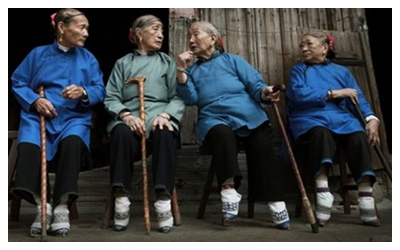
Chinese women footbinding
 According to experts on folklore, Chinese footbinding originated in the Southern Tang Dynasty (937-976). The so-called "three-inch golden lotuses" refer to women's tiny bound feet, and also refer to the shoes they wore: they were in the shape of a rising bird head. Their treads were wooden, in a bent shape like a bow. Therefore, they were called "bow shoes", which originally meant bent-tread shoes, but later generally referred to the small shoes worn by foot-bound women.
According to experts on folklore, Chinese footbinding originated in the Southern Tang Dynasty (937-976). The so-called "three-inch golden lotuses" refer to women's tiny bound feet, and also refer to the shoes they wore: they were in the shape of a rising bird head. Their treads were wooden, in a bent shape like a bow. Therefore, they were called "bow shoes", which originally meant bent-tread shoes, but later generally referred to the small shoes worn by foot-bound women.In the Yuan and Ming Dynasties, there was a rule that footbinding was permitted only for women from noble families. The bow shoes of that time had treads as high as 4 - 5 Cun. By the Qing Dynasty, "three-inch golden lotuses" worn by the Han women had won the favor of the Manchu women.
The Qing court issued orders many times to prohibit Manchu people from footbinding, but still many Manchu women liked to follow it. Threfore, footbinding became very popular among them. There are various kinds of bow shoes: sleeping shoes, Huanjiaoxie (shoes for change of feet), sharp-crested shoes, Tatangxie (shoes for walking in the main room), net shoes, lotus shoes, overshoes, funeral shoes, female shoes, and so on. The exquisite bow shoes had various kinds of embroidered patterns at the toe, the tread, the inside and the upper. Rich women's bow shoes even had some bright pearls or other ornaments on them.







 Ask Questions ?
Ask Questions ?